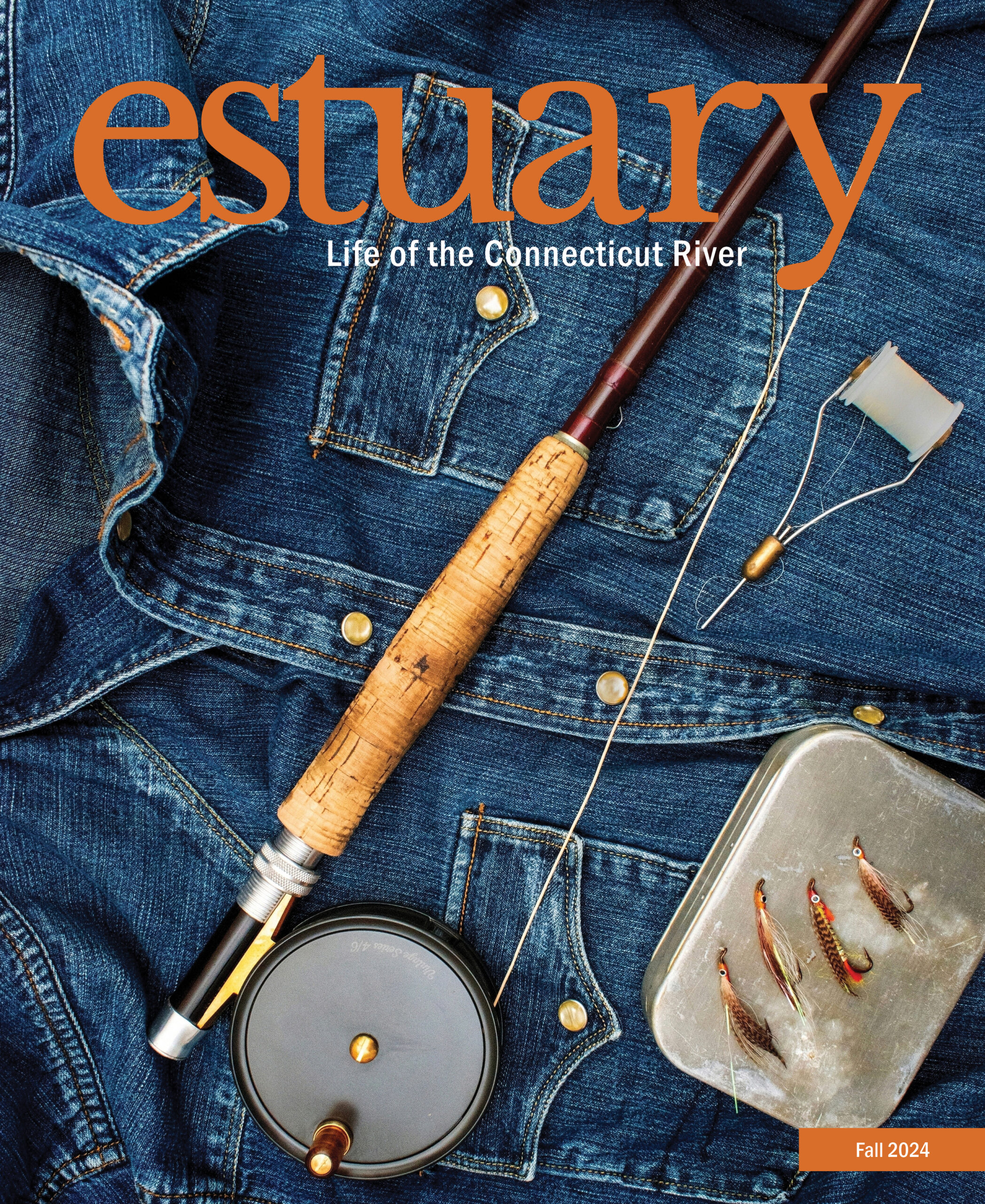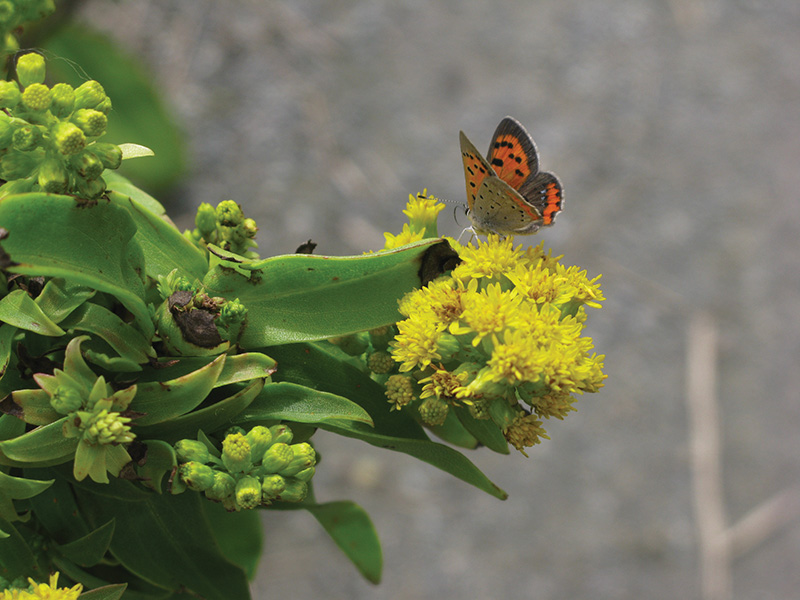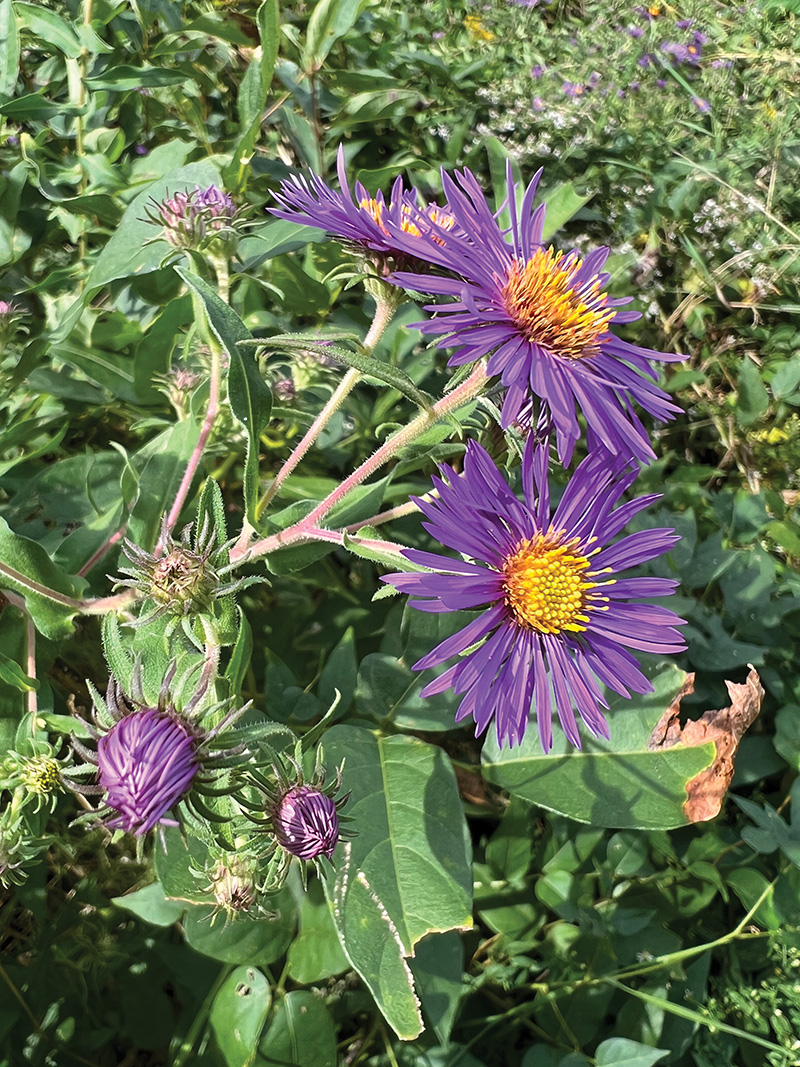 This article appears in the Fall 2024 issue
This article appears in the Fall 2024 issue

Ask for Them by Name
These Plants Have Superpowers!

American Copper butterfly on a seaside goldenrod (Solidago sempirvirens).
Fall is a great time for flowers. They bring a crescendo of color and activity before shorter days and cooler temperatures. Our wildlife gardens are transitioning into a storehouse of seeds and hollow stems that will provision next year’s plant and animal life.
In New England three familiar native flowers that are fall bloomers are asters, goldenrods, and wild sunflowers. These three plants also share a distinction: they are “powerhouse plants,” what University of Maryland entomologist and native plant advocate Doug Tallamy states are among the only five percent of our native plants that support seventy-five percent of the insects that drive nature’s food web.
Included in that 5 percent are a select number of native trees (the oak, for example, is the most productive tree in the country in terms of supporting caterpillars). But in our gardens, it is our local asters, goldenrods, and perennial sunflowers that, you could say, have superpowers.
Knowing this, it stands to reason that if you are looking for ways to help shore up our fragmented and—it would seem at times—beleaguered natural world, here is an opportunity to do so—with the added benefit of the potential for a lovely garden, filled with life. So, let’s take a closer look at these surprisingly accessible hero-plants.

Bumblebee on goldenrod.
Goldenrods (Solidago)
Before you groan, know that goldenrod is not contributing to your pollen allergies. Goldenrods have sticky pollen that do not become airborne. And not all goldenrods are the Canada goldenrod (Solidago Canadensis) that is an aggressive spreader and common old field plant that spreads by underground runners. (On the other hand, if you need a productive native to fill a lot of space quickly, this is your plant.)
Well over twenty species of goldenrods are found in New England alone. Despite often being overlooked, these plants support more than 125 species of specialist native bees and butterfly caterpillars (that are essential, particularly, for birds). Especially at the end of the growing season, migratory butterflies including the familiar Monarch (Danaus plexippus) and Painted Lady (Vanessa cardui) rely on goldenrods as an essential food source.
A goldenrod to consider (and ask for at your local nursery), is the grass-leaved goldenrod, Euthamia graminifolia. Unlike its beefier cousin, the Canada goldenrod, Euthamia has slender, pointed leaves and rarely grows taller than three feet if given plenty of sun. It is drought-tolerant and accommodates both wet and dry soil. It prefers ample space to spread but can be easily pulled to edit its space in the garden. On a sunny, warm late fall day, this lesser-known goldenrod can be loaded with a wide variety of fall insects, including Monarch butterflies moving through, but also bumblebees, flies, wasps, and bees.
The seaside goldenrod (Solidago sempervirens) is a durable and vigorous grower. This fleshy-leaved goldenrod is uniquely adapted to salt, wind, and periods of drought, making it perfect for our nearshore, estuarine waters.
Asters (Symphyotrichum)
The native asters have been divided into multiple genus groups; many of the most familiar are in the genus Symphyotrichum. Similar to the goldenrod, asters support close to 120 species of bees and butterfly caterpillars, making them a great addition to your garden to boost its productivity.
Perhaps the most popular, and certainly one of the most beautiful, is the New England aster (Symphyotrichum novae-angliae), recognizable by its clusters of deep purple flowers with yellow centers. This plant prefers moist, rich soil and full sun. In the wild, where it often shares sun and resources with diverse vegetation, it frequently maintains a height of not more than three feet; in the well-tended garden this plant can reach up to six feet. But it responds well to being pinched back, even multiple times, before midsummer to promote bushiness.

New England aster.
Under ideal conditions, such as the mild and moist winter we experienced last year in southern New England, the white wood aster (Eurybia divaricate) can become dense in our wooded understory where flowers, in general, are less prevalent. It is shade tolerant and can grow in dry, sloping, and less fertile soils. This is an excellent plant for naturalizing below existing trees in your home landscape.
Native Sunflowers (Helianthus)
We think of sunflowers as those cheerful, tall yellow flowers with large centers that ripen into seeds for birds and other wildlife in the fall. That plant, the field-sunflower (Helianthus annuus) is a crop, like corn, that, although originally bred by Native American farmers and planted far and wide, is not native to the northeast. The tall tuberous sunflower (Helianthus tuberosus), mysteriously named Jerusalem artichoke, is also not naturally occurring in New England and in some southern states is even considered invasive.
But that is not to say that we have no native sunflowers. The woodland sunflower (Helianthus divaricatus) brings a bright yellow to shaded understories and can thrive in full sun in your garden, where it hosts abundant butterflies and bees. Similarly, the oxeye sunflower (Helianthus helianthoides) produces abundant clusters of orange-yellow flowers on tall stems reaching up to six feet.
It makes sense to provide some portion of your garden to these beneficial flowering plants—never more needed than now as our climate changes, wild landscapes disappear, and non-native and invasive plants and animals continue to impact local ecosystems. Doug Tallamy suggests a 70/30 native to non-native balance as a goal. Our native flowers not only support our local food webs but also provide a regional aesthetic identity to our New England landscape. But if you love bearded iris, your family has always had bearded iris, and they are a harbinger of your spring or childhood, then keep them! I grow them in my garden because they came from my mom’s (and her mother’s) garden.
These three flowering perennials are starting to become available at local nurseries in their unadulterated or “straight” genetic form. That means you can look for, and increasingly find, the botanic name without the added modifiers—words such as “Fireworks,” “Double Delight,” and “Firefly Sunshine” that indicate that the plant has been cultivated to favor specific, often cosmetic, characteristics that may be at the expense of what the local ecosystem needs. The best way to ensure genetic diversity—the means by which natural populations can adapt to changing conditions over time—is to ask for a native plant by its botanic name.
Alternatively, the best way to ensure natural gene variation is to grow out the seeds of wild native plants. We will look at how to do this in the upcoming winter issue.
Judy Preston is a local ecologist active in the Connecticut River estuary.
